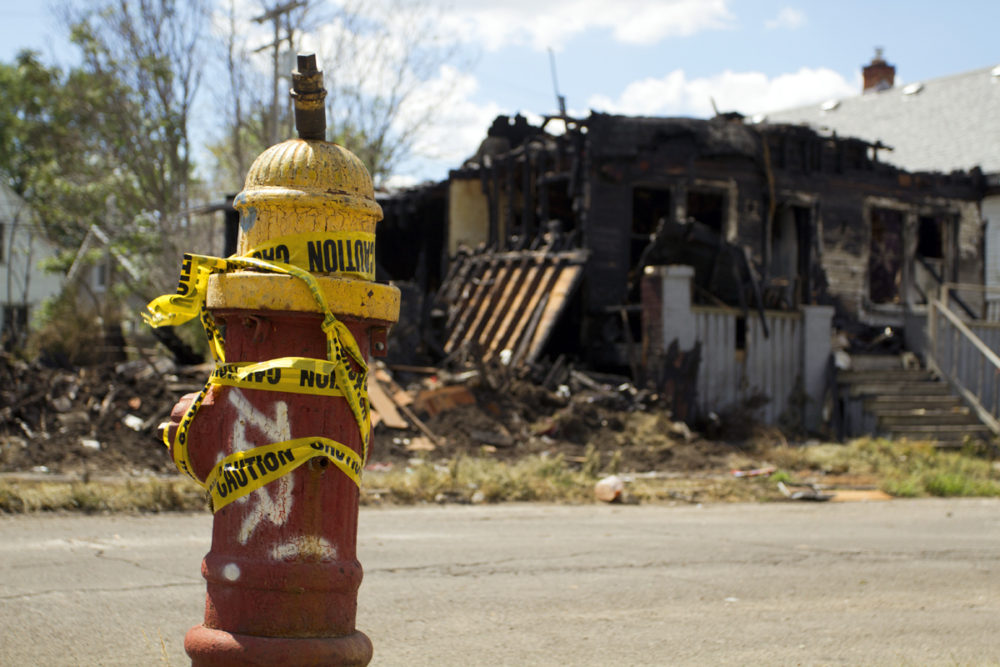
When an arsonist set fire to a vacant house in southwest Detroit on July 31, firefighters arrived within minutes. But across the street, the hydrant was broken, wrapped for months in yellow caution tape.
The water pressure on the next hydrant was so low it was useless.
By the time firefighters found a reliable hydrant on Proctor Street, the blaze spread to two neighboring houses, and 20-foot flames were so hot they melted the plastic siding off of four occupied houses across the street.
“It was terrifying,” recalled Lisa Gonzalez, who lives on Proctor Street. “I thought we were going to lose the whole block.”
Detroit’s long-neglected hydrants are failing at alarming rates, and the century-old underground system that supplies the water is crumbling far faster than the city’s Water and Sewerage Department (DWSD) can maintain it. As a result, insurance rates are rising and fires are burning longer and frequently spreading to next-door homes and businesses in neighborhoods that are struggling to survive, according to a one-year Motor City Muckraker investigation involving thousands of public records, a lawsuit we filed against the city, dozens of interviews with residents, fire officials and hydrant experts, an examination of more than 3,000 structure fires and a review of post-fire photos and data collected by Loveland Technologies.
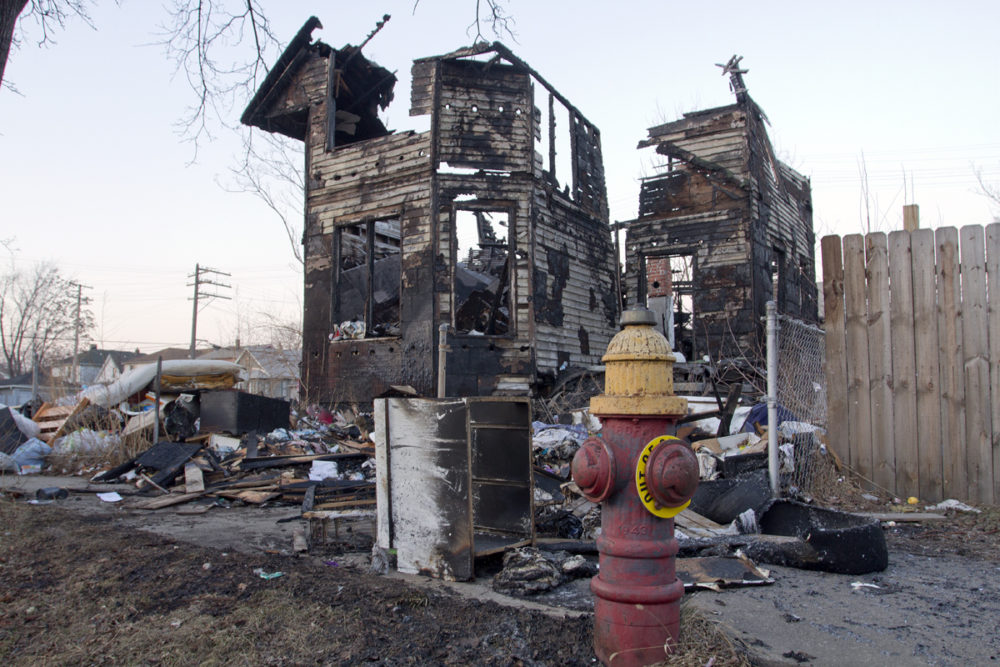
The findings were disturbing:
- As many as half of the city’s 28,000 hydrants are broken, defective or in danger of freezing this winter.
- An astounding 57% of the working hydrants had inadequate water pressure to extinguish an average house blaze, according to a random sample examined by outside experts.
- Hundreds of defective hydrants were left out of service for six months or more, leaving entire blocks without immediate access to water.
- DWSD routinely failed to fix persistent water pressure problems in the lowest-income areas.
- At least 12 firefighters were injured at fires where hydrants or water pressure was a problem.
The findings wildly contradict DWSD’s claims in March that only about 70 hydrants were broken throughout the city, even as firefighters were impeded almost daily by bad hydrants. A Motor City Muckraker investigation that month revealed the problems were far more significant than DWSD was willing to acknowledge, prompting Mayor Mike Duggan to launch an ambitious, long-overdue plan to fix the hydrants.
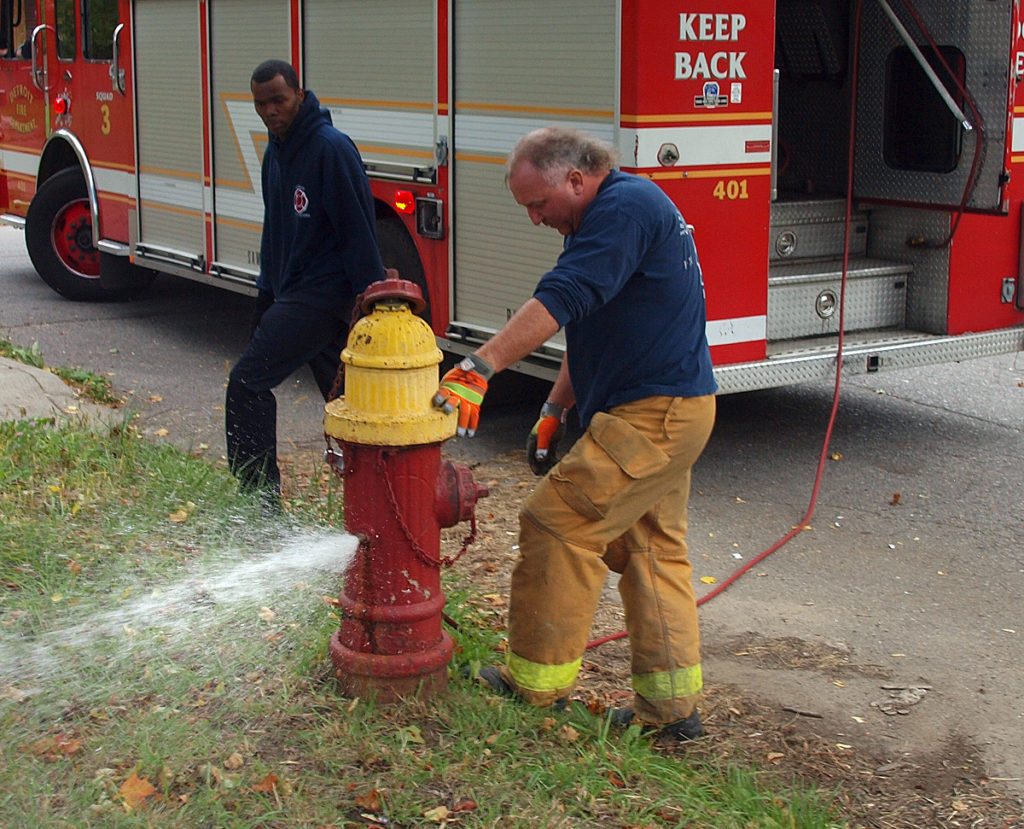
The effort took off this summer when firefighters began inspecting all of the city’s 28,000 hydrants for the first time in at least a decade. What they found was startling: As many as half of the hydrants are broken, defective or in danger of freezing this winter, according to inspection records obtained under the Michigan Freedom of Information Act.
But that’s only part of the problem. Large swaths of the city have inadequate water pressure to extinguish house and building fires. This year, firefighters lost control of hundreds of fires because of low pressure from the city’s antiquated water infrastructure, according to fire department records and hundreds of hours of radio traffic from fire scenes.
Of the hydrants that work, about 57% had inadequate water pressure to extinguish most fires, according to a random sample of about 100 hydrants examined by New Jersey-based Insurance Services Office (ISO).
“It’s very abnormal to find that many hydrants with low water pressure,” James McMullen, a California-based hydrant expert and consultant, told Motor City Muckraker.
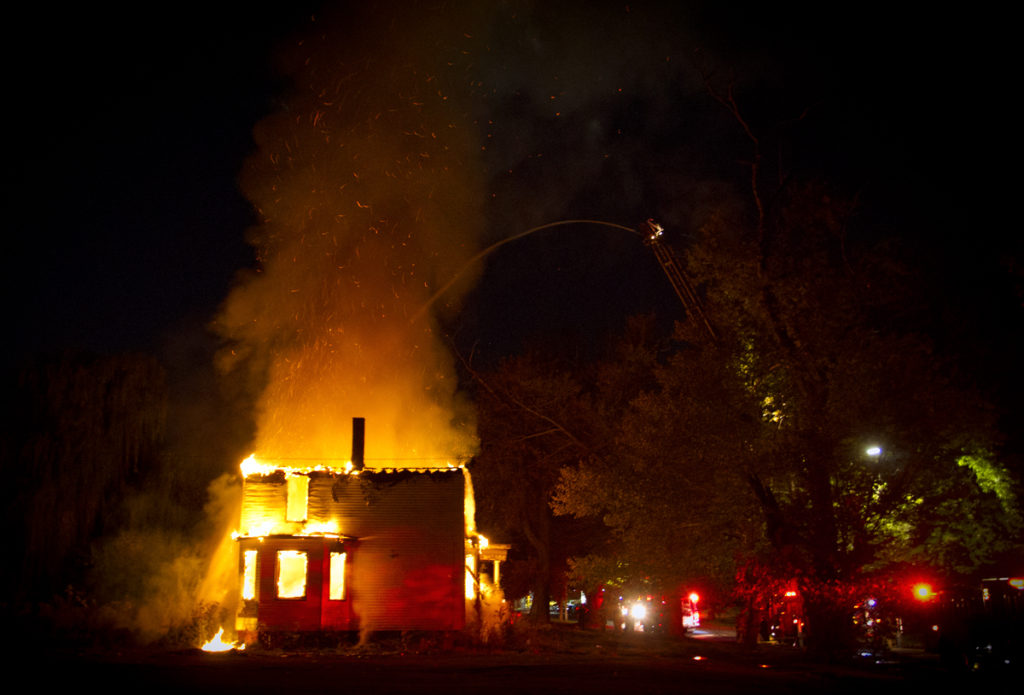
Largely because of the water supply problems and the city’s failure to adequately monitor them, ISO recently downgraded Detroit’s insurance rating for the first time in 25 years, causing a spike in premiums that already were the highest in the state.
And it’s no surprise.
A Motor City Muckraker analysis of all 3,000-plus fires in houses, businesses and other buildings this year revealed that DWSD often fails to fix recurring water pressure problems at the expense of some of the city’s most endangered neighborhoods.
That’s largely because DWSD doesn’t even keep track of where firefighters are thwarted by low-water pressure, officials acknowledged. DWSD also has failed for at least a decade to test each hydrants for pressure, a standard practice in most cities and one recommended every five years by the National Fire Protection Agency (NFPA).
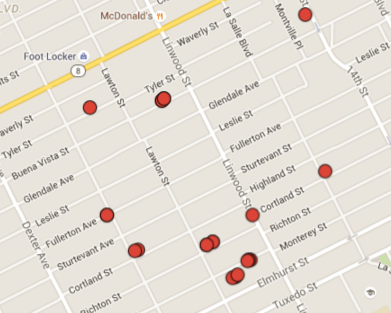
In a small section of the west side near Linwood and the Davison this year (see map), firefighters were impeded by bad hydrants and water pressure 10 times in the first nine months.
DWSD was lax in correcting the problems, so firefighters continued to struggle at most fires in that area.
On July 8, a suspicious fire broke out in a vacant apartment building on Richton near Linwood. Firefighters scrambled for more than an hour to find a hydrant with water pressure as fast-growing flames tore through the building.
“We got water supply problems in this whole neighborhood,” the chief notified dispatchers.
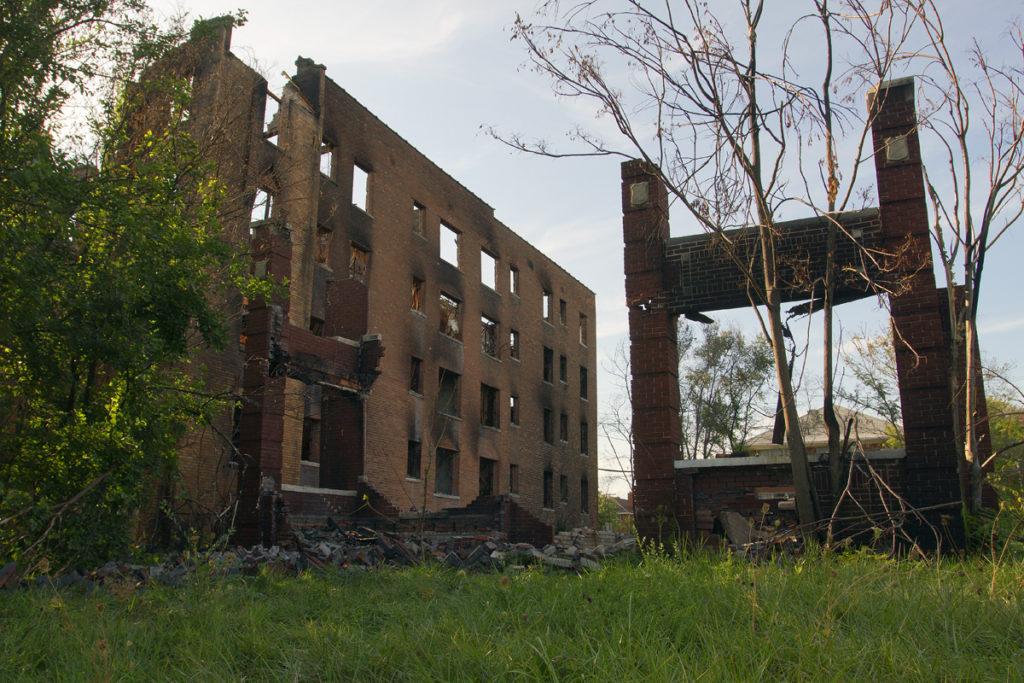
By the time a hydrant was found, the blaze spread to an ornate four-story apartment complex, devouring both buildings.
Two firefighters were injured.
A month later, one block west on Cortland, a fire ripped through a large brick home that was under renovation. The house burned to the ground because firefighters had no water pressure.
Three blocks south on Monterey, firefighters were called to another house fire on Sept. 15 – two months and a week after firefighters first reported the lack of water pressure. When firefighters arrived, they had no water pressure and couldn’t stop the fire from spreading to two next-door homes.
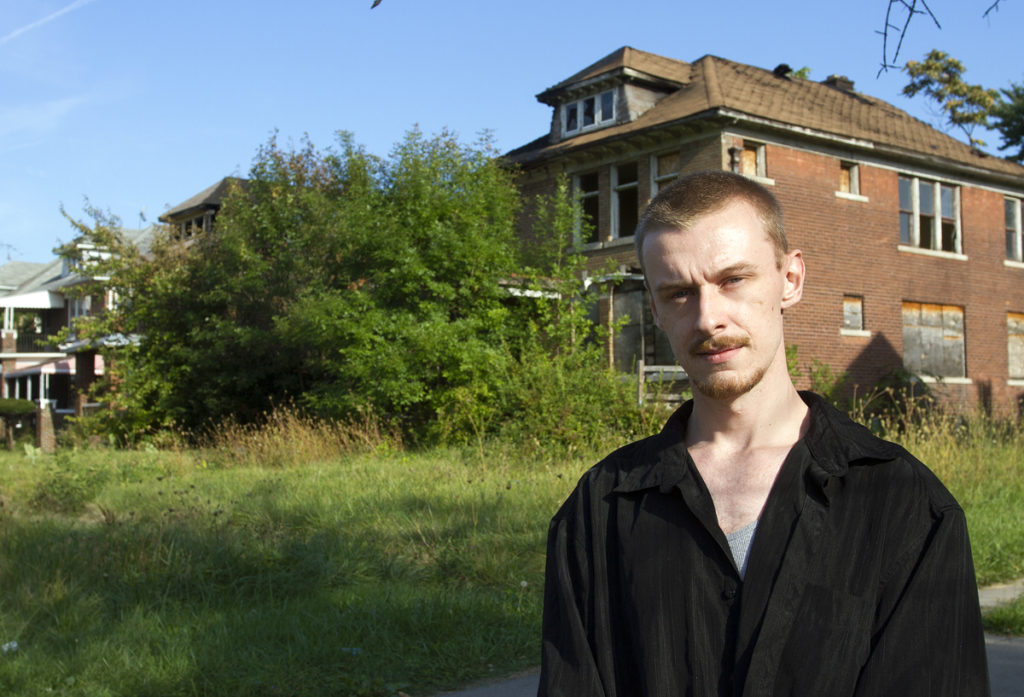
“I might be better off with a garden hose and a Bible,” said Larry Reeves, 26, who watched as flames nearly reached his house. “How many people have to roast in their beds before there’s better equipment and hydrants? We’re not asking for much.”
Finally, a day after the Monterey fire, DWSD fixed the low-water pressure.
“DWSD found a valve that was not fully opened from a repair that occurred during the winter season,” said Palencia Mobley, deputy director and chief engineer at DWSD.
Residents were so fed up they erected hand-painted signs with skulls on a fence outside one of the burned apartment buildings on Richton, accusing Duggan of ignoring the problems.
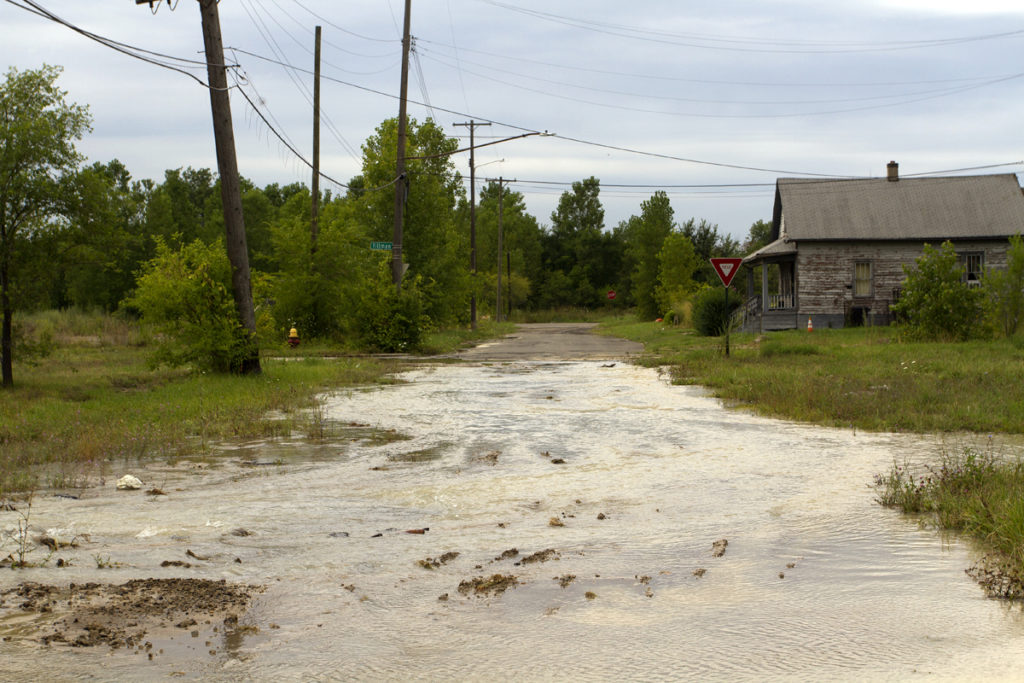
But Duggan said his administration is doing the best it can with limited resources. The aging water system includes 3,500 miles of long-neglected pipes, many of which are so brittle that pressure from open hydrants have broken hundreds of mains this year.
Duggan’s administration hired eight crews to tackle the problem, but not even that is enough.
“The city has struggled for decades with the effects of a lack of investment in its old water infrastructure, some of which is more than 100 years old,” Duggan told us. “That is starting to change.”

Duggan noted that the city will begin receiving $50 million a year for 40 years “to replace old mains for a more reliable water system, including our fire hydrants,” as part of a deal with the suburbs to lease water assets from Detroit.
“This will begin to address many of the issues residents face today,” the mayor said.
But, he acknowledged, “It’s going to take some time, but we are headed in the right direction.”
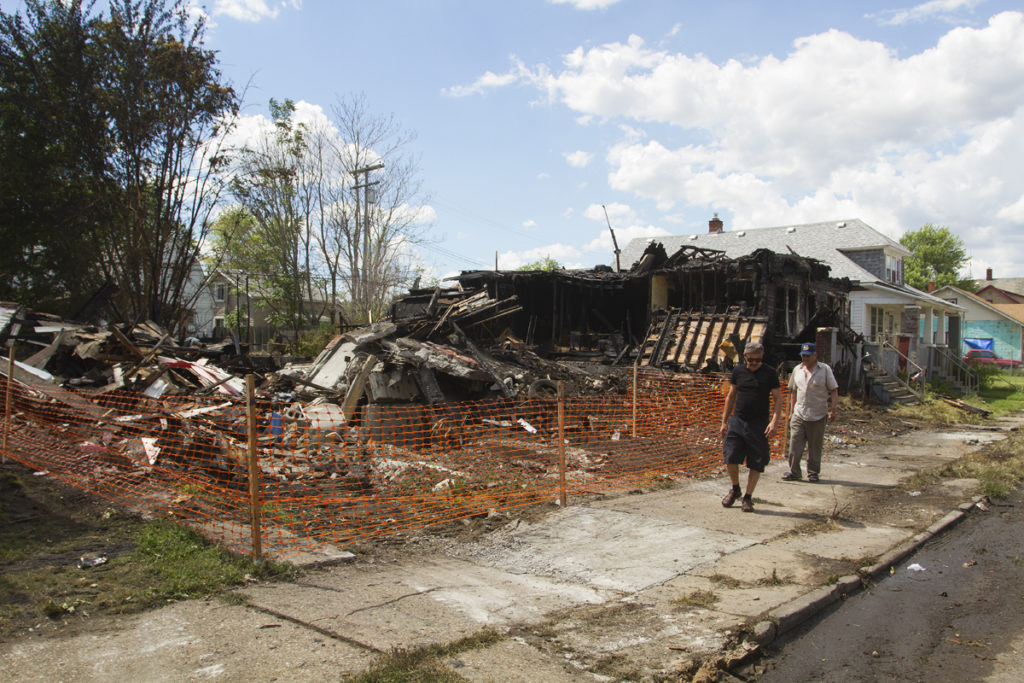
A Motor City Muckraker analysis found that fires with defective hydrants or water pressure problems were disproportionately destructive, spreading to at least 118 neighboring houses, apartment buildings and businesses this year. About three-quarters of the houses and buildings either collapsed or were destroyed, compared to 47% of all structure fires during the same period. At least 12 firefighters were injured.
Access to working hydrants and strong water pressure are critical to saving lives. On Feb. 27, firefighters were called to an occupied house fire on Marcus Street near the border of Hamtramck. When the first firefighters arrived six minutes later, Dante Brown and his friend were pulling two injured children and an adult from the rapidly burning house.
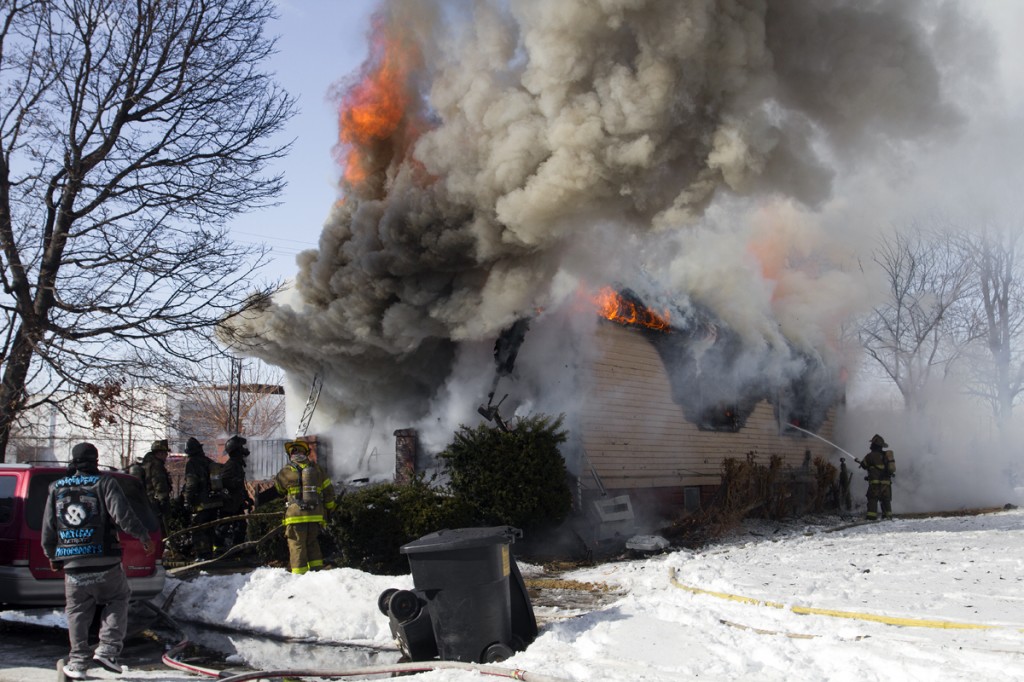
But firefighters’ opportunity to save the grandmother was dashed when they struggled with the first hydrant.
“I want everybody out of the house,” the chief radioed to firefighters as flames began to rip through the second-floor windows. “Nobody goes in.”
Brown, 42, was in tears.
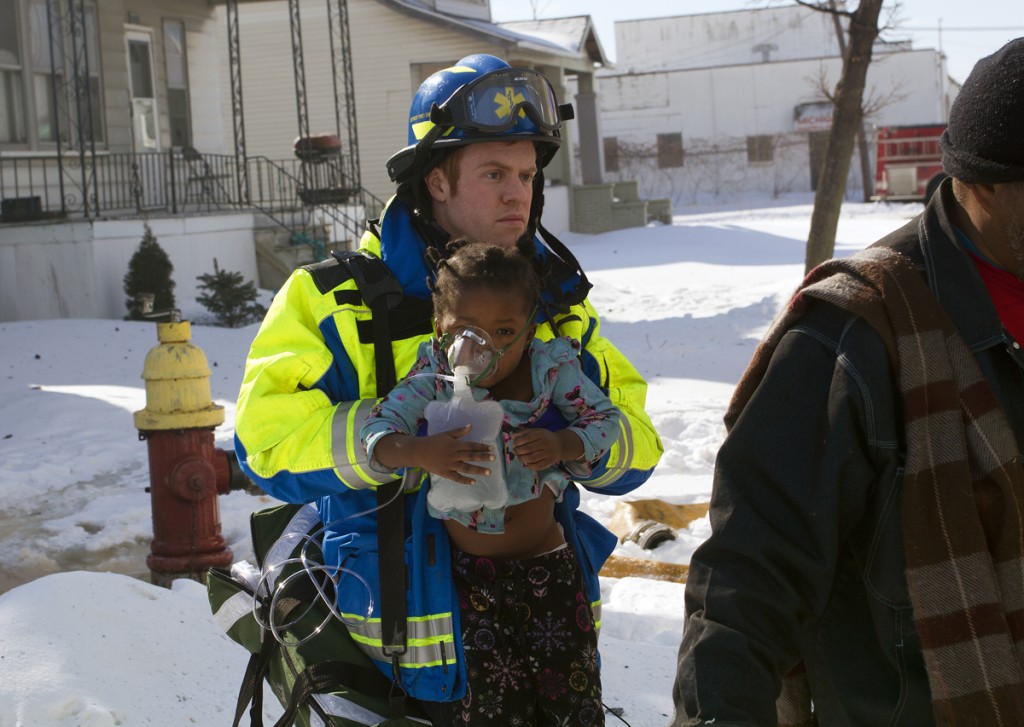
“She was upstairs,” he said, his hands trembling. “We tried. There was nothing we could do.”
On Valentine’s Day, firefighters rushed to a house on the 16000 block of Carlisle and were told, “There are supposed to be women and children inside.” Flames grew as firefighters failed to get water from the first hydrant. It took 20 minutes before they could knock down the flames enough to search the house, which luckily was unoccupied at the time.
“Issues with low pressure and bad hydrants jeopardize the safety of our firefighters and the lives of those we swear to protect daily,”said Mike Nevin, president of the Detroit Fire Fighters Association.
Virtually no part of the city was without defective hydrants or water supply issues this year. But most of the problems occurred in lower-income areas where arsons are the most frequent and where people are the least likely able to afford homeowner insurance, according to log books and records obtained through a Freedom of Information Act lawsuit against the city.
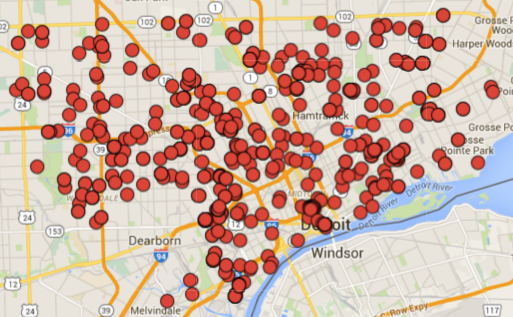
Those records also show that DWSD waited six or more months to fix dozens of broken hydrants, a disproportionate number of which are in areas where a controversial city blueprint, Detroit Future City, calls for transforming large swaths of residential land into urban farms, meadows, forest and marshes. Those neighborhoods also have been the most impacted by arsons and fire station closures over the past three years.
Take the area of Hantz Woodlands, an experimental project to transform about 150 acres into tree farms throughout a residential area on the east side. Over the past year, firefighters have encountered more bad hydrants and water pressure problems in that area than any other section of the east side.
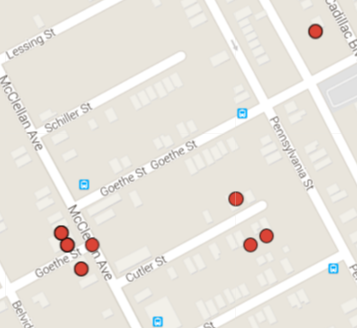 In an eight-block area surrounding Goethe, which runs through the heart of Hantz Woodlands, low-water pressure hampered firefighters at six fires between June 8 and Oct. 14. As a result, six houses and two apartment buildings collapsed, another house was gutted and two more were damaged.
In an eight-block area surrounding Goethe, which runs through the heart of Hantz Woodlands, low-water pressure hampered firefighters at six fires between June 8 and Oct. 14. As a result, six houses and two apartment buildings collapsed, another house was gutted and two more were damaged.
One of those homes belongs to Ann Frantz, who loved the idea of owning “a little country house in the middle of the ‘farm.'”
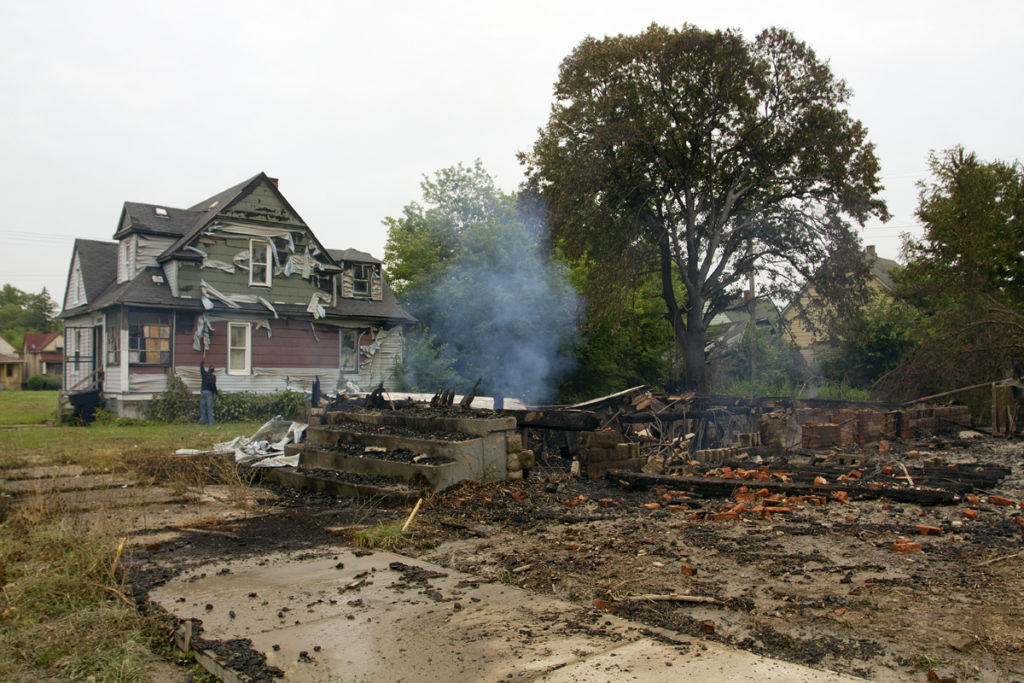
But fires devoured most of her block on Cutler. In the early morning hours of Aug. 10, the siding on her home melted like candle wax as flames tore through a brick house across the street. A small child could be seen framed through an upstairs window, looking on in horror.
“This is the closest it has come to burning,” Frantz said. “I would like to insure (the house), but unfortunately, Detroit has not figured out how to help us get a rating that insurers are willing to underwrite.”
The fire also damaged the next-door house of Kenneth Kirby, who was cleaning the charred debris from his house 12 hours after the blaze broke out, smoke still wafting from a burning tree and the collapsed house next door.
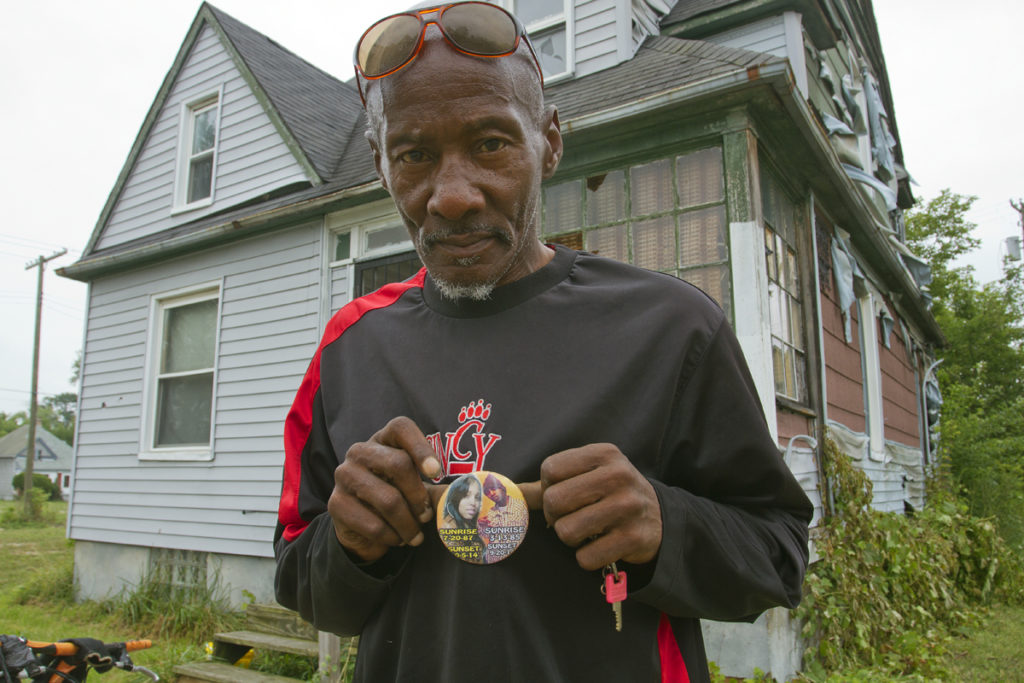
“This is no way to live,” Kenneth Kirby, 61, said, his voice heavy with grief. “All you can do is pray. There’s nothing else you can do.”
Motor City Muckraker inspected the 150-acre Hantz Woodlands area and discovered 12 out-of-order hydrants this fall. More than 75 house fires broke out in the area in the past three years, city records show.
When firefighters encounter low pressure, they often have to wait for DWSD to manually open the valves that supply the water, a process that can take an hour or more. On at least three occasions, DWSD failed to arrive.
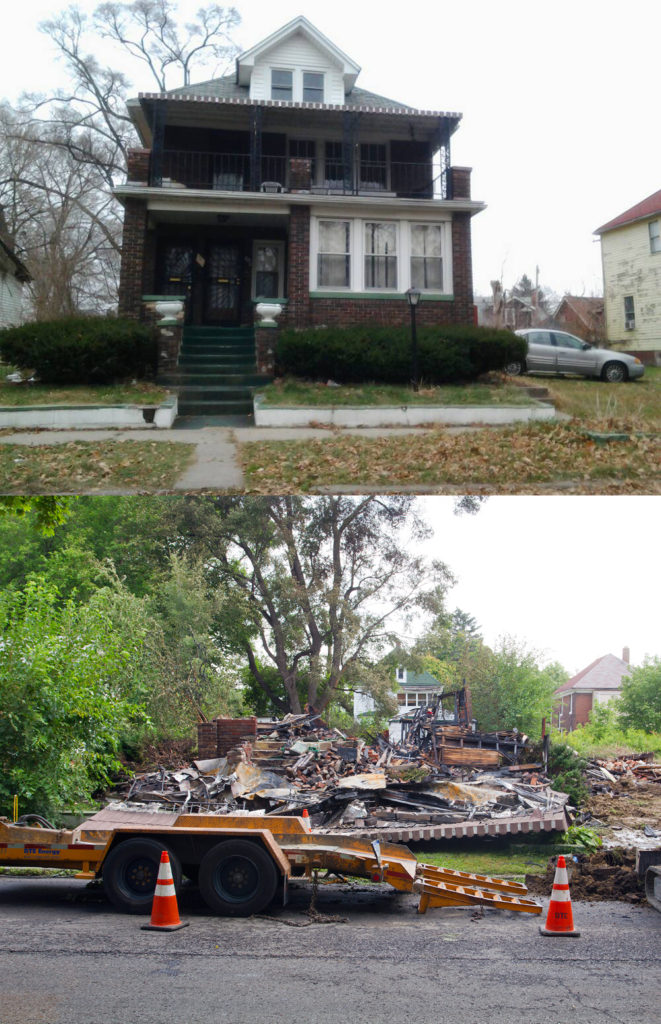
On Aug. 13, a fire broke out in an occupied house at Maxwell and E. Canfield, an area riddled with water supply problems. Hydrant after hydrant failed.
“I have no water pressure; I don’t know what to do,” a firefighter told the chief as flames began to spread to the next-door house.
Firefighters were helpless as they waited an hour for DWSD to arrive. Softball-size embers began to rain down on houses a block away, catching at least one occupied house on fire.
In a nine-day period in September, two fires broke out on the same block of South Solvay in the struggling neighborhood of Delray in southwest Detroit. The same hydrant malfunctioned at both fires, which gutted a vacant apartment building and destroyed two occupied houses. Records show that one of the hydrants was out of service for at least nine months.
A few weeks earlier, just blocks away on Medina, firefighters lost control of a house fire because of two bad hydrants. Two houses collapsed, and raging flames melted off the siding of an adjacent house.
But the worst may be yet to come.
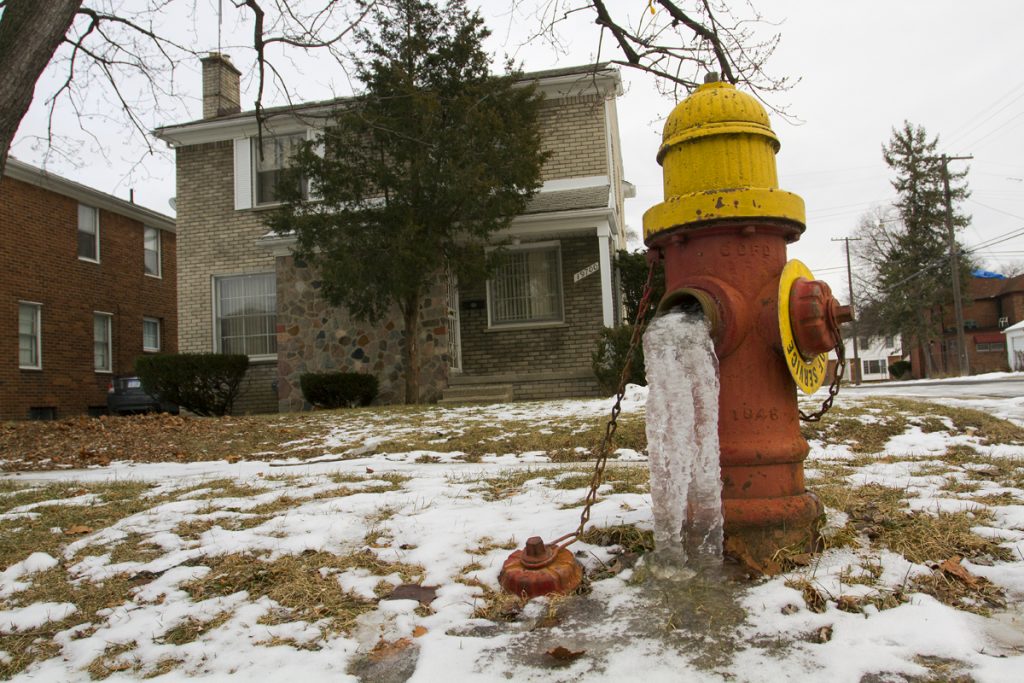
As many as 12,474 hydrants are leaking underground, which means they are in danger of freezing this winter, according to inspection data.
Firefighters were alarmed by the results.
“While in the field, we are finding low pressure, and many hydrants are out of service, just to name a few issues, but feel we will have a GREATER problem this winter,” Lt. Nevin warned his superiors in an email dated Sept. 16.
Hydrants freeze when water leaks into the barrel through a broken valve beneath the frost line, a problem that led to significant fire damage last winter. This year, firefighters found more than 12,000 hydrants that needed to be pumped of water that was above the frost line.
Because leaks are the overwhelming reason hydrants have to be pumped, fire experts warn the city is facing a crisis once the temperatures plummet.
“You have to have a dry hydrant, or it will freeze in the winter and not work because the passageway is blocked by ice,” McMullen said. “So it’s very critical that those hydrants are maintained.”
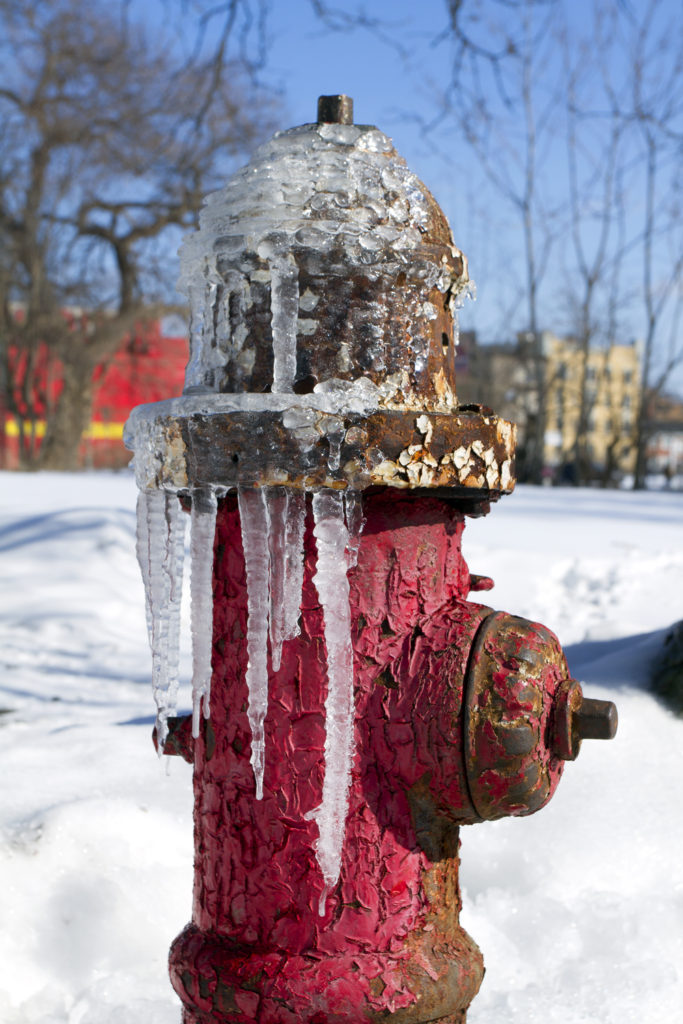
Firefighters from eight companies interviewed for this story said that an overwhelming majority of the hydrants that were pumped of excess water were found to be leaking during follow-up inspections.
“If you do a functional test and you pump the hydrant, and you come back in a month and find water in the barrel, it absolutely indicates a leak,” said Dave Fornell, a fire operations expert who works for Detroit Fire Commissioner Eric Jones.
In the first two months of this year, frozen hydrants stymied firefighters dozens of times, causing otherwise manageable fires to consume at least four occupied houses. On Feb. 16, firefighters lost control of a basement fire in an occupied 99-year-old colonial in the Boston-Edison Historic District because the first two hydrants, one of which was frozen, didn’t work.
“I lost everything,” Graves said a day after the fire. “The firefighters did everything they could. But what can you do without working hydrants?”
After sharing some of Motor City Muckraker’s findings with the city, DWSD officials said they plan to meet soon with the fire administration to improve communications and more effectively respond to water supply problems.
“As we all know, our system has many years of service on it and it is our intent to make the necessary upgrades and changes in a systematic and thoughtful manner,” Mobley of DWSD said. “There are many factors that must be accounted for in executing our comprehensive capital improvement program and we intend to work together with all city agencies to have the necessary inputs to rebuild Detroit.”
Steve Neavling
Steve Neavling lives and works in Detroit as an investigative journalist. His stories have uncovered corruption, led to arrests and reforms and prompted FBI investigations.

9 Responses to "About half of Detroit’s hydrants are defective – and that’s only part of the problem"